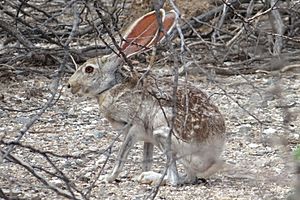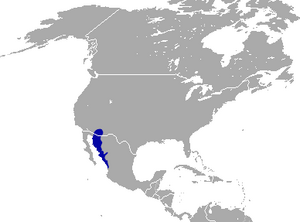Antelope jackrabbit facts for kids
Quick facts for kids Antelope jackrabbit |
|
|---|---|
 |
|
| Conservation status | |
| Scientific classification | |
| Genus: |
Lepus
|
| Species: |
alleni
|
 |
|
| Antelope jackrabbit range | |
The antelope jackrabbit (Lepus alleni) is a type of hare found in the dry desert areas of Southern Arizona in the United States and Northwestern Mexico. It's part of the Leporidae family, which includes rabbits and hares. These jackrabbits are quite large, with very long, pointy ears. Both male and female antelope jackrabbits look the same.
They have a white belly, light grey sides, a black-speckled back, and orange fur on their neck and chest. They are most active around sunrise and sunset (this is called crepuscular) and at night (nocturnal). However, they can also be active during the day if it's cloudy. They eat plants like cacti, mesquite leaves, and other green stuff.
Contents
How Did Antelope Jackrabbits Evolve?
Scientists use fossils to learn about animals from the past. Fossils show that the group of animals called Lepus (which includes hares) lived in North America about 2.5 million years ago. An extinct jackrabbit, Lepus giganteus, lived during this time. It looked a lot like the antelope jackrabbit.
Researchers believe that L. giganteus might have been an ancestor to both the antelope jackrabbit and the black-tailed jackrabbit. The black-tailed jackrabbit lives in the same areas as the antelope jackrabbit. Studies also suggest that the white-sided jackrabbit is a common ancestor to the antelope jackrabbit and the Tehuantepec jackrabbit.
Where Do Antelope Jackrabbits Live?
In the United States, you can find the antelope jackrabbit in parts of Arizona. In Northwestern Mexico, they live in states like Chihuahua, Nayarit, Sinaloa, and Sonora.
Compared to other hares in North America, the antelope jackrabbit lives in a smaller area. They don't live further east than the sky islands in Arizona or the Sierra Madre Occidental mountains in Mexico. They also don't go west of Florence, Arizona. Sometimes, they are spotted in places like the Lake Mead Recreational Area in Nevada.
What Kind of Habitat Do They Prefer?
Antelope jackrabbits live in different warm and tropical places. They like grassy hills or plains, especially areas with large desert shrubs rather than just long grass. They can also be found in more open desert habitats.
Studies show that the best home for an antelope jackrabbit has grassy ground cover and mesquite trees overhead. They don't like very dry climates. Instead, they prefer areas that get a good amount of rain in the summer. They also live in places with higher humidity, unlike the black-tailed jackrabbit, which prefers drier conditions.
What Do Antelope Jackrabbits Look Like?
The antelope jackrabbit is the largest type of Lepus species. Its body can be about 52 to 58 cm (22 in) long. Its tail is usually 5 to 10 cm (3 in) long. Their front legs are about 10 to 20 cm (3.9 to 7.9 in) long, and their back legs can grow to be 20 to 30 cm (7.9 to 11.8 in) long.
Their ears are very long, about 14–17 cm (6 in), with white tips and edges. The tail has two colors: black on top and light grey underneath. Antelope jackrabbits have light grey sides, an orange neck and chest, and a back that looks speckled with black. They can weigh up to about 4 kilograms (9 pounds).
What Do Antelope Jackrabbits Eat?
Antelope jackrabbits eat cacti, different types of grasses, and other leafy plants. They have even been seen digging and eating soil. They do this to get important minerals and nutrients.
Because they eat mostly leaves, they are called folivores. Since they also eat a lot of grass, they are known as graminivores.
How Do Antelope Jackrabbits Reproduce?
Antelope jackrabbits usually breed from December to September. Their pregnancy lasts about six weeks. A female can have up to four litters (groups of babies) each year. Each litter can have one to five babies.
A baby hare is called a leveret. Leverets are born very developed; their eyes are open, they are active, and they are covered with fur. Young leverets are born in shallow nests. These nests are made by scraping a small dip in the ground.
What Threats Do Antelope Jackrabbits Face?
Some animals that hunt antelope jackrabbits include bobcats, coyotes, and golden eagles. Humans also hunt these jackrabbits. Sometimes they are hunted because they attract predators that might also harm farm animals. They are also hunted for their meat or their fur.
Losing their natural homes is another big threat to antelope jackrabbits. As farms grow larger, they take over the jackrabbits' habitats. Also, farm animals like cows and sheep eating too much grass can reduce the food available for jackrabbits in their living areas.
See also
 In Spanish: Liebre antílope para niños
In Spanish: Liebre antílope para niños



